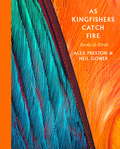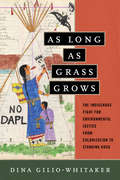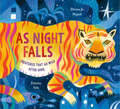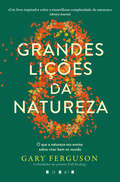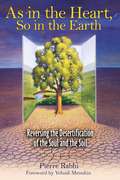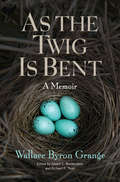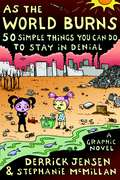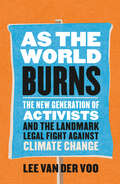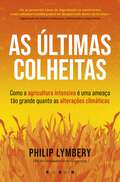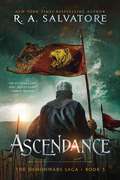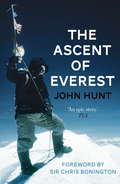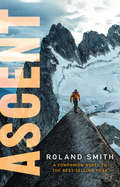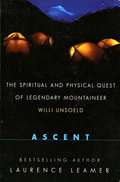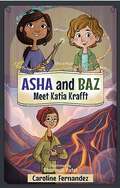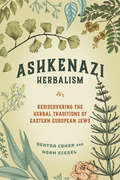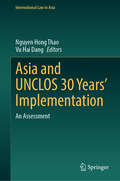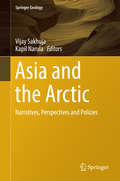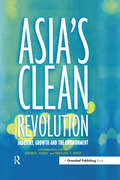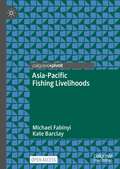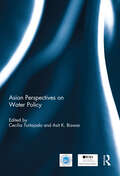- Table View
- List View
As Kingfishers Catch Fire: Birds & Books
by Neil Gower Alex Preston'Delightful . . . an original look at the literature inspired by Britain's birdlife' the Guardian, Best Nature Books of 2017'[The] pages light up with feathered magic' Evening StandardWhen Alex Preston was 15, he stopped being a birdwatcher. Adolescence and the scorn of his peers made him put away his binoculars, leave behind the nature reserves and the quiet companionship of his fellow birders. His love of birds didn't disappear though. Rather, it went underground, and he began birdwatching in the books that he read, creating his own personal anthology of nature writing that brought the birds of his childhood back to brilliant life. Looking for moments 'when heart and bird are one', Preston weaves the very best writing about birds into a personal narrative that is as much about the joy of reading and writing as it is about the thrill of wildlife. Beautifully illustrated and illuminated by the celebrated graphic artist Neil Gower, As Kingfishers Catch Fire is a book to love and to hold, to return to again and again, to marvel at the way that authors across the centuries have captured the endless grace and variety of birds. It will make you look at birds, at the world, in a newer, richer light.'A joyful and a wondrous book . . . Each bird illustrated by Gower in a mixture of gouache and watercolour that brings to mind both William Morris and Eric Ravilious' the Observer'I can see it under the Christmas tree of every family with a bird feeder and a copy of the RSPB Handbook . . . Preston captures his birds beautifully' The Times
As Kingfishers Catch Fire: Birds & Books
by Neil Gower Alex Preston'A magical book: an inimitable fusion of ornithology, literary anthology and autobiography.' Tom HollandWhen Alex Preston was 15, he stopped being a birdwatcher. Adolescence and the scorn of his peers made him put away his binoculars, leave behind the hides and the nature reserves and the quiet companionship of his fellow birders. His love of birds didn't disappear though. Rather, it went underground, and he began birdwatching in the books that he read, creating his own personal anthology of nature writing that brought the birds of his childhood back to brilliant life. Looking for moments 'when heart and bird are one', Preston weaves the very best writing about birds into a personal and eccentric narrative that is as much about the joy of reading and writing as it is about the thrill of wildlife. Moving from the 'high requiem' of Keats's nightingale to the crow-strewn sky at the end of Alan Garner's The Weirdstone of Brisingamen, from Ted Hughes's brooding 'Hawk in the Rain' to the giddy anthropomorphism of Jonathan Livingstone Seagull, this is a book that will make you look at birds, at the world, in a newer, richer light. Beautifully illustrated and illuminated by the celebrated graphic artist Neil Gower, As Kingfishers Catch Fire is a book to love and to hold, to return to again and again, to marvel at the way that authors across the centuries have captured the endless grace and variety of birds.'A joyful and a wondrous book' the Guardian
As Long as Grass Grows: The Indigenous Fight for Environmental Justice, from Colonization to Standing Rock
by Dina Gilio-WhitakerThe story of Native peoples' resistance to environmental injustice and land incursions, and a call for environmentalists to learn from the Indigenous community's rich history of activismThrough the unique lens of "Indigenized environmental justice," Indigenous researcher and activist Dina Gilio-Whitaker explores the fraught history of treaty violations, struggles for food and water security, and protection of sacred sites, while highlighting the important leadership of Indigenous women in this centuries-long struggle. As Long As Grass Grows gives readers an accessible history of Indigenous resistance to government and corporate incursions on their lands and offers new approaches to environmental justice activism and policy. Throughout 2016, the Standing Rock protest put a national spotlight on Indigenous activists, but it also underscored how little Americans know about the longtime historical tensions between Native peoples and the mainstream environmental movement. Ultimately, she argues, modern environmentalists must look to the history of Indigenous resistance for wisdom and inspiration in our common fight for a just and sustainable future.
As Night Falls: Creatures That Go Wild After Dark
by Donna Jo NapoliThis science-themed picture book is for the littlest nature aficionado. Bursting with vibrant illustrations, it offers an inviting look into the secret world of how nature goes BERSERK at night!As night falls. The earth cools. Waters calm. Winds hush…But outside, night time is action time for some.Silly action. Hungry action. Wild action. From microscopic organisms to giant cats, it's surprising who you'll find awake in the middle of the night! Dinoflagellates guzzle floating bacteria, bumblebee bats loop and swoop, racer snakes slither, weasels sneak and circle, and spot-bellied eagle owls leap and sweep. One by one, the animals of the food chain find their next scrumptious treat.For children whose curiosity abounds, and restless sleepers greedy for one more story or one more goodnight kiss, this distinctive picture book with a science focus gives a peek at the animals that come alive at night. The striking words of Donna Jo Napoli join the electric and wild illustrations of acclaimed artist Felicita Sala to make this the perfect picture book to help young readers get out all their wiggles and giggles before bed.
As Oito Grandes Lições da Natureza: O Que a Natureza Nos Ensina Sobre Viver Bem no Mundo
by Gary FergusonO que a natureza nos ensina sobre viver bem no mundo Um manifesto poderoso sobre a interdependência de tudo o que existe na natureza e sobre como poderemos viver uma vida mais gratificantes e nos reconectarmos com o mundo natural. Durante demasiado tempo, vivemos separados da natureza, vendo-nos como superiores, distantes, independentes. Porém, ao fazê-lo, perdemos de vista tudo o que o mundo natural nos pode ensinar. Neste livro, Gary Ferguson revela-nos as surpreendentes complexidades que podemos encontrar na natureza, bem como a sabedoria que advém do mundo natural, da sua diversidade, dos seus mistérios e da sua capacidade de resiliência perante a mudança. Baseando-se em áreas que vão desde a ciência e a psicologia à filosofia e à história, Gary Ferguson desvenda a deslumbrante teia de conexões que temos com a natureza, enfatizando a necessidade de voltarmos a estabelecer uma ligação com o mundo natural para potenciarmos o nosso bem-estar físico, mental e espiritual e redescobrirmos a nossa humanidade. Porque, afinal, nós somos natureza. «Um livro que nos faz refletir e nos ensina a viver em harmonia e equilíbrio com o mundo em nosso redor.» Kirkus Reviews
As in the Heart, So in the Earth: Reversing the Desertification of the Soul and the Soil
by Yehudi Menuhin Pierre RabhiThe world’s leading expert on reversing soil desertification shows how ecology can flourish only when spiritual elements are present• Uses a parable from the African oral tradition to provide a living testimony of what has been lost with the rise of modern technology• Provides a vital account of the strong relationship between soil and soul and how this relationship can be restoredAs in the Heart, So in the Earth is a strong indictment of a civilization that, while seeking domination over the earth, mutilates, tortures, and desacralizes it. For Pierre Rabhi ecology is inseparable from spirituality. He shows how the growing desertification of North Africa is a reflection of the “desert” that is claiming the hearts and souls of the inhabitants of the Western world--how dead soil is mirrored in our deadened souls--and how reconciliation with Mother Earth must be accompanied by relearning our ancestors’ reverence for the soil.Using a traditional African parable grounded in the very wisdom of the earth, Pierre Rabhi seeks to initiate the reader into a time when the people that dwelled on this planet did so harmoniously and could converse easily with the land. Village elder Tyemoro recounts the gradual destruction of his village’s culture and all that has sustained it as the miracles promised by modern technology brought more harm than good. This same drama is recurring throughout the world, where indigenous value systems that have endured for millennia are torn apart by contact with modern civilization. Yet Rahbi offers hope--if those in the modern world will stop to hear the words of their ancestors who worked the land, for our destiny is linked irrevocably to that of the earth.
As the Twig Is Bent: A Memoir
by Wallace Byron GrangeWallace Byron Grange (1905–87) was an influential conservationist who worked alongside Aldo Leopold. Grange’s story vividly describes his mostly idyllic childhood watching bird life in the once grand prairies just west of Chicago. He documents his family’s journey and pioneering struggle to operate a farm on the logged cutover country in northern Wisconsin, a land that provided him with abundant opportunities to study the lives of wild creatures he loved most. Written when Grange was in his sixties, As the Twig Is Bent conveys how a leading conservationist was formed through his early relationship to nature. In beautifully composed vignettes, he details encounters both profound and minute, from the white-footed mice attracted by cookie crumbs in his boyhood clubhouse to the sounds of great horned owls echoing through the wintry woods. As he develops his own understanding of the natural world, he comes to an awareness of the dramatic and devastating role of humankind on ecosystems. Grange’s poignant observations still resonate today amid global conversations about the fate of our natural resources and climate change.
As the World Burns: 50 Simple Things You Can Do to Stay in Denial
by Derrick Jensen Stephanie McmillanTwo of America's most talented activists team up to deliver a bold and hilarious satire of modern environmental policy in this fully illustrated graphic novel. The U.S. government gives robot machines from space permission to eat the earth in exchange for bricks of gold. A one-eyed bunny rescues his friends from a corporate animal-testing laboratory. And two little girls figure out the secret to saving the world from both of its enemies (and it isn't by using energy-efficient light bulbs or biodiesel fuel). As the World Burns will inspire you to do whatever it takes to stop ecocide before it's too late. <P><P> <i>Advisory: Bookshare has learned that this book offers only partial accessibility. We have kept it in the collection because it is useful for some of our members. Benetech is actively working on projects to improve accessibility issues such as these.</i>
As the World Burns: The New Generation of Activists and the Landmark Legal Fight Against Climate Change
by Lee van der Voo&“The story of Juliana v. United States and the committed young people behind it will give you hope in the next generation.&” —Elizabeth Kolbert, author of The Sixth Extinction Do children have a right to inherit a livable planet? Is the government obliged to protect it? That&’s the question posed by Juliana v. United States, one of the most critical lawsuits of our time. Twenty-one young people from across America sued the federal government over climate change, charging that actions promoting a fossil fuel economy violate their constitutional rights to life, liberty, and property. Their trial could be the civil rights trial of the century, but it hasn&’t happened yet. As the World Burns follows the plight of the young plaintiffs, chronicling their legal battle through a year of drought and wildfire, floods and hurricanes, and the most tumultuous political season in modern history. The plaintiffs wrenchingly describe personal experiences with recurring &“thousand-year&” floods, wildfire smoke so thick they can&’t ride a bike to school, drought that threatens family farms, and disappearing coastlines that send waves lapping ominously at their doors. Along the way, journalist Lee van der Voo weaves their experience into a broader narrative of America, where politics and policy threaten the very existence of our youth and our way of life.As the World Burns is climate breakdown like you&’ve never seen it—through the eyes of the young.
As Últimas Colheitas: Como a Agricultura Intensiva É uma Ameaça Tão Grande Quanto as Alterações Climáticas
by Philip LymberyUma visão provocadora do futuro, que nos desafia a pensar melhor acerca do que compramos e comemos, e do impacto das nossas escolhas nas alterações climáticas. Partindo de um alerta perturbador das Nações Unidas de que os solos do mundo se podem esgotar no período de uma vida, Philip Lymbery, uma das pessoas mais influentes na indústria alimentar, percorre os bastidores do grande agronegócio em vários pontos do mundo, revelando como a pressão sobre os solos constitui uma ameaça séria à nossa sobrevivência. Nas suas pesquisas, porém, o autor também encontra esperança nas práticas de pioneiros que estão a repensar os métodos agrícolas, a redescobrir técnicas tradicionais e a desenvolver tecnologias para alimentar uma população global em constante expansão. Influente e persuasivo, este livro alerta para a realidade do sistema alimentar global, demonstrando como podemos regenerar os solos do mundo, acabar com a crueldade animal, salvar a vida selvagem, estabilizar o clima e salvaguardar o planeta para as gerações futuras. Os elogios da crítica: «Philip Lymbery expõe este assunto essencial sob a perspetiva de um ativista experiente — conhecedor o suficiente para ficar chocado, mas suficientemente moderado para nos persuadir a assumir a responsabilidade pelo sistema que nos alimenta.» — The Guardian«Neste livro extremamente bem escrito, cuja leitura aconselho vivamente, Philip Lymbery descreve como a agricultura intensiva prejudica o meio ambiente e inflige sofrimento aos animais sencientes, propondo alternativas sustentáveis para resolver o problema. Há de facto esperança para o nosso planeta, e cada um de nós pode desempenhar um papel.» — Jane Goodall, primatologista fundadora do Instituto Jane Goodall e mensageira da paz das Nações Unidas«Um livro extremamente importante que deve ser lido por todos os que desejam que a humanidade sobreviva para além do período de uma vida. As soluções propostas devem ser implementadas como se o nosso futuro dependesse disso — e de facto depende.» — Andrew Knight, Professor de Ética e Bem-Estar Animal da Universidade de Winchester «Um relato persuasivo e contundente sobre como a agricultura industrial está a impulsionar as emergências climáticas e a pôr em risco a biopersidade, ao mesmo tempo que prejudica a nossa saúde. Este livro é um apelo à ação.» — Isabella Tree, autora e jornalista premiada
Ascendance: The DemonWars Saga, Book 5 (DemonWars series #5)
by R. A. SalvatoreYears have passed since the great miracle atop Mount Aida, and Corona is a different place—yet a threat looms, one Kilseponie could never have anticipated in this next installment in the DemonWars series from bestselling author R. A. Salvatore.Much to the seething dismay of his long-time mistress, King Danube has asked Julsepnie Wyndon to become his queen. But she is torn. How can she love any man as completely as she did the Ranger Elbryan, the father of the child she lost? But unknown to Jilseponie, that child never died. Aydrian was stolen away by the queen of the elves. A headstrong boy secretly raised to be a weapon, Aydrian shows great promise in the arts of combat, and he is as powerful with the gemstone as his mother. Now, De&’Unnero, the weretiger and mortal enemy of Jilseponie, will join forces with Aydrian, who is hungry for power and on a collision course with destiny. Building upon the events in Mortalis, #1 New York Times bestselling author R.A. Salvatore continues the fresh second trilogy within the DemonWars saga with his fifth book in the series.
Ascent of Everest: Special Sales
by John Hunt'This is the story of how, on 29 May, 1953, two men, both endowed with outstanding stamina and skill, reached the top of Everest and came back unscathed to rejoin their comrades. 'Yet this will not be the whole story, for the ascent of Everest was not the work of one day, nor even of those few anxious, unforgettable weeks in which we prepared and climbed this summer. It is, in fact, a tale of sustained and tenacious endeavour by many, over a long period of time... We of the 1953 Everest Expedition are proud to share the glory with our predecessors.'Sir John Hunt
Ascent: A Peak Marcello Adventure (A Peak Marcello Adventure)
by Roland SmithPeak Marcello goes to Mayanmar to climb one of the most isolated mountains in the world in this thrilling new novel from bestselling author Roland Smith. After conquering the mountains in Afghanistan, Peak Marcello goes to Myanmar, a country that has been in the grips of a brutal military regime for more than fifty years, to visit Alessia. When he’s invited to climb Hkakabo Razi, one of the most isolated mountains in the world, Peak can’t pass up the opportunity. But getting to the mountain will involve a four-week trek through tropical rainforests rife with hazards—from venomous reptiles and leeches to corrupt police and military. In the end, summiting Hkakabo Razi may be the easiest thing Peak does.
Ascent: The Spiritual and Physical Quest of Legendary Mountaineer Willi Unsoeld
by Laurence LeamerWilli Unsoeld, a legend among mountaineers--a man whom Bill Moyers calls one of the few giants he has ever met--fearlessly challenged the world's highest peaks and inspired a generation of climbers with his legacy. Ascent is the story of his life--a thrilling tale of physical and spiritual adventure that captures the hypnotic force behind this extraordinary personality. From his triumphant conquest of Everest's forbidding West Ridge to the tragic loss of his daughter on the treacherous slopes of Nanda Devi to his final, fatal attempt at Mount Rainier, we see Willi as guru and guide, lover of danger and philosopher of risk--a man whose indomitable spirit triggered such devotion that people followed him fearlessly to extraordinary heights and, sometimes, even to their deaths. A dramatic saga of bravery, daring, and the search for spiritual truth, Ascent brilliantly captures the mythic figure of Willi Unsoeld.
Ash Road
by Ivan SouthallA raging fire spreading in the Australian bush cuts off the escape of the children and two old men entrusted to their care.
Asha and Baz Meet Katia Krafft (Asha and Baz)
by Caroline FernandezIn the fourth book in the Asha and Baz series, readers learn about volcanoes from renowned volcanologist Katia Krafft!Asha wants to win a super cool volcanic rock by solving the Great Volcano Challenge at school. So she and her best friend Baz use their magic stick to travel to Iceland in 1973 to learn from famous volcano researcher Katia Krafft.She's sure to be able to help them with their project, but she's got an eruption to observe and data to record—and ash, lava, and smelly gases are a lot more scary than a classroom. With safety concerns rising, Asha and Baz will need to keep their cool to get back home and win the prize.
Ashkenazi Herbalism: Rediscovering the Herbal Traditions of Eastern European Jews
by Deatra Cohen Adam SiegelThe definitive guide to medicinal plant knowledge of Ashkenazi herbal healers, from the Middle Ages to the 20th century.Until now, the herbal traditions of the Ashkenazi people have remained unexplored and shrouded in mystery. Ashkenazi Herbalism rediscovers the forgotten legacy of the Jewish medicinal plant healers who thrived in eastern Europe's Pale of Settlement, from their beginnings in the Middle Ages through the modern era.Including the first materia medica of 25 plants and herbs essential to Ashkenazi folk medicine, this essential guide sheds light on the preparations, medicinal profiles, and applications of a rich but previously unknown herbal tradition--one hidden by language barriers, obscured by cultural misunderstandings, and nearly lost to history. Written for new and established practitioners, it offers illustrations, provides information on comparative medicinal practices, and illuminates the important historical and cultural contexts that gave rise to eastern European Jewish herbalism.Part I introduces a brief history of the Ashkenazim and provides an overview of traditional eastern European medicine. Part II offers descriptions of predominantly Jewish towns in the Pale, their many native plants, and the remedies applied by indigenous healers to treat a range of illnesses. This materia medica names each plant in Yiddish, English, Latin, and other relevant languages. Ashkenazi Herbalism also details a brief history of medicine; the roles of the Ba'alei shem, Feldshers, Opshprekherins, midwives, and brewers; and the seferot.
Ashley Jackson's Watercolour Sketches
by Ashley JacksonA collection of drawings by the landscape artist famed for his moody portrayals of the Yorkshire moors, including his personal reflections. I am not one for pretty pictures. Perhaps when I am long gone this will be a quote that I am remembered for alongside my paintings. For you will mostly find me in the gallery on a sunny day and out on the moors when it is at its most inhospitable, for these are the days that captivate me. Ashley Jackson's Watercolour Sketches is a collection of the artist&’s raw drawings combined with his intimate thoughts and feelings. Jackson uses his sketchbook the same way others create diaries of words, and it reflects his relationship with the Yorkshire landscape. Originally intended only as his personal recollections, they are now shared in this book, allowing us to join him in his artistic journey and conversation with nature.
Ashley Jackson's Watercolour Sketches
by Ashley JacksonA collection of drawings by the landscape artist famed for his moody portrayals of the Yorkshire moors, including his personal reflections. I am not one for pretty pictures. Perhaps when I am long gone this will be a quote that I am remembered for alongside my paintings. For you will mostly find me in the gallery on a sunny day and out on the moors when it is at its most inhospitable, for these are the days that captivate me. Ashley Jackson's Watercolour Sketches is a collection of the artist&’s raw drawings combined with his intimate thoughts and feelings. Jackson uses his sketchbook the same way others create diaries of words, and it reflects his relationship with the Yorkshire landscape. Originally intended only as his personal recollections, they are now shared in this book, allowing us to join him in his artistic journey and conversation with nature.
Ashley Jackson: An Artist's Life
by Chris BondAshley Jackson has had an extremely distinctive and illustrious life in the world of art. Since opening his first gallery back in 1963, he has become one of the country's leading and most successful landscape watercolorists. His unique evocative and distinctive paintings of brooding moorlands have become synonymous with Yorkshire, and more particular the moors above and around his Gallery situated in the heart of the Pennines, Holmfirth. His works have been exhibited worldwide, and adorn the walls of many successful and famous people, from politicians to actors, from Tsars to Princes. Ashley was honored when former US President, Bill Clinton, an avid art collector, was presented with an original watercolor. Ashley, throughout his career, has always been an ambassador for the arts. He has strived through his life to encourage people not just to take up art, but to appreciate the beauty of the landscape around us. His exhibitions have included "Ashley Jackson One Man Exhibition" at Patchings Artfarm, Calverton Notts in 2003 and "Ashley Jackson's Yorkshire Moors—a love affair"—Victoria Quarter, Leeds in 2002. He has also held exhibitions in New York, Chicago and Milan. His awards include the 2006 Life Time Achievement Award from Yorkshire Awards, and the 2007 Life Time Achievement Award from the Huddersfield Examiner. He is the present day Ambassador for Northernart. The local artist has done extensive charity work in the past and is part of the Prince's Trust.
Asia and UNCLOS 30 Years’ Implementation: An Assessment (International Law in Asia)
by Nguyen Hong Thao Vu Hai DangThis book provides critical legal analyses of latest developments in ocean law and policy by leading Asian legal scholars in the 5 years leading up to the 30th anniversary of the United Nations Convention on the Law of the Sea (UNCLOS) entering into force on 16 November 1994. The Asia’s maritime domain, including both the Pacific and Indian Oceans, is currently facing a plethora of serious challenges, ranging from maritime and territorial disputes (especially in the South China Sea and East China Sea), competition between superpowers, piracy and armed robbery at sea, the degradation of marine environment, IUU fishing, to sea-level rising. This book allows readers to explore and understand how the scholars in the region examine, conceive, understand, and suggest solutions to these challenges.
Asia and the Arctic: Narratives, Perspectives and Policies (Springer Geology)
by Vijay Sakhuja Kapil NarulaThis book presents narratives, perspectives and policies on the Arctic and brings to fore the strategies of five Asian countries - China, India, Japan, Republic of Korea and Singapore who were granted the status of Permanent Observers in the Arctic Council in 2013. The book also captures Arctic countries' reactions to Asian approaches, and their expectations from these countries. The melting of the polar sea-ice induced by climate change has placed the Arctic region in the forefront of global scientific, economic, strategic and academic interest. The discourse involves a number of issues such as claims of the littoral countries to the continental shelves of the region, the management and exploitation of its living and non-living resources, the rights and interests of indigenous communities, and the prospects of new ice-free shipping routes. The contemporary discourse also suggests that the Arctic region presents challenges and offers opportunities for the international community. These issues have given rise to new geopolitical, geoeconomic, and geostrategic dynamics amongst the Arctic littorals, and led to the growing interest of non-Arctic states in the affairs of the Arctic. It is evident that the Asian countries have a variety of interests in the Arctic, and the grant of Permanent Observer status to these countries is an acknowledgement of their capabilities. These countries are keen to explore opportunities in the Arctic, and have begun to formulate appropriate long-term national strategies. The preliminary approach of the Asian Observer countries has rightly been to graduate from 'involvement' to 'engagement' in the Arctic, which seems to have generated significant interest amongst analysts. This book helps to understand the approaches of various Arctic and non-Arctic stakeholders, in light of the evolving dynamics in the region.
Asia's Clean Revolution: Industry, Growth and the Environment
by David Angel Michal RockThe world's environmental future will be determined in significant part by what happens in the rapidly industrialising and urban economies of Asia. The sheer scale of urban population and industrial growth in Asia - from Indonesia to China - and the energy and materials intensive character of the development process constitutes a dark shadow over the region's, and indeed the world's, environment. And yet this challenge is also an opportunity. Precisely because so much of the urban-industrial investment within developing Asia has yet to take place, the opportunity exists to shape a different development future - one that is far less energy, materials and waste intensive.Asia's Clean Revolution examines the prospects for and pathways to such a new trajectory. The book lays out a path-breaking vision of how developing economies might go beyond environmental regulation and put in place an array of policies and institutions that could integrate environmental, industrial and technological goals. These findings provide important input for negotiators considering climate change on a global scale.The book approaches the challenge of growth and environment in Asia in a novel way, by identifying six major transformational dynamics under way in the world today, and assessing whether these can be harnessed to the goal of improved environmental performance of industry.With a set of specially commissioned chapters from the leading authorities in North America and Asia, this ground-breaking book is the first to present concrete policy solutions to the looming crisis driven by large-scale urban-industrial growth in developing Asia.
Asia-Pacific Fishing Livelihoods
by Kate Barclay Michael FabinyiThis open access book explores fishing livelihoods in the context of the wider contexts in which they are embedded. Drawing on case studies from across the Asia-Pacific region, the book highlights how fishing livelihoods are shaped by globalisation, social relationships and governance. The book concludes by showing how better understanding these relationships can contribute to governance for healthier ecosystems and social wellbeing.This is an open access book.This is an open access book.
Asian Perspectives on Water Policy (Routledge Special Issues on Water Policy and Governance)
by Asit K. Biswas Cecilia TortajadaAsian countries are not homogenous. They are in different stages of social and economic development, with cultural conditions and institutional and legal frameworks varying from one country to another. Therefore, how water can be successfully managed differs from one country to another. The book provides authoritative analyses of how water is being managed in different Asian countries, ranging from the world’s most populous countries like China and India to a city state like Singapore and an island country like Fiji. It also analyses in depth several wide ranging issues like terrorism, human rights, water-energy nexus, and roles of media, along with comprehensive discussions of legal, institutional and regulatory frameworks in an Asian water management context. The overall focus is on how water can be managed efficiently, cost-effectively and equitably in various Asian countries.This book was based on a special issue of the International Journal of Water Resources Development.
